by Lisa Cooke | May 7, 2016 | 01 What's New, Ancestry, Beginner, Brick Wall, Census, Records & databases, Research Skills
When may it pay off to look at the same records or indexes twice? When you can compare them on different genealogy websites. Here’s an example for this census research tip. 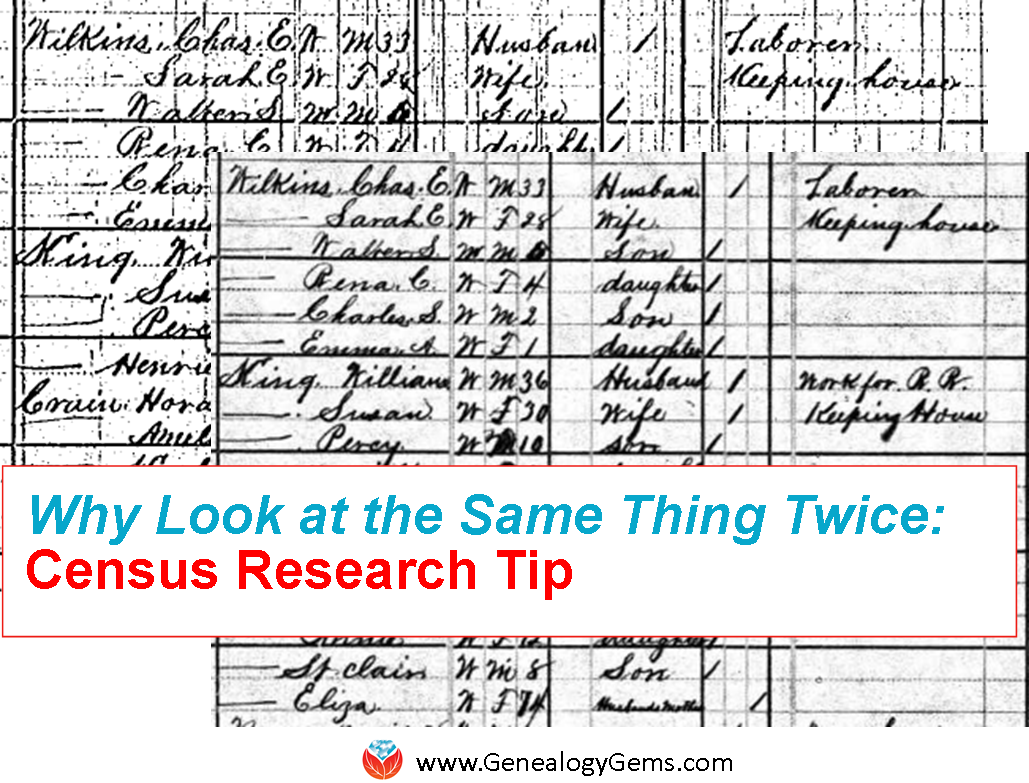
You’ve probably noticed that some record sets are available online at multiple websites. At each site, the images and indexes you find may be a little different. Online tools for viewing and searching at each site may also be different.
For example, a digitized image may be faded, dark, blurry, blotchy, cut off, or otherwise unreadable on one website but clearer on another site. Here are two images from the first few lines of the 1880 U.S. Federal Census taken in Bay Minette, Baldwin, Alabama. The first image comes from HeritageQuest Online (available at public libraries) and the second is from Ancestry.com. See the difference?
As you can see, depending on which line you’re reading, one image may be clearer than another.
Here’s another census research tip: The online tools available at each site are different, too. At HeritageQuest Online, you can view the image at original size, 200% or 400%, and you can look at the image as a negative, which sometimes helps faded text stand out a little more. Ancestry.com lets you zoom in and out, magnify specific areas, and rotate the image or view it in mirror form (in case you’re trying to read backward text bleeding through from the other side).
More Gems for Online Genealogy Research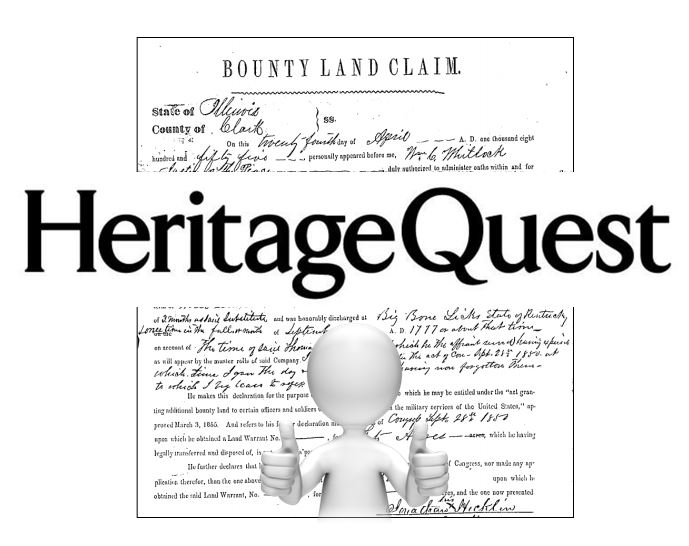
HeritageQuest Online Gets Better with Ancestry’s Support
4 Tips for Getting the Most out of Ancestry.com
Genealogy Gems Premium podcast episode 125: HeritageQuest Online, Ancestry Library edition and other great genealogy resources at the public library (Available only to Genealogy Gems Premium website members)
by Lisa Cooke | Oct 23, 2017 | 01 What's New, DNA, Trees |
If you’re doing DNA tests for family history, you may see lots of predicted cousin matches: 2nd, 3rd, 4th, etc…..But what does that predicted genetic relationship actually mean? Learn about centimorgans, the powerful genetic genealogy unit of measure, and how it helps your research.
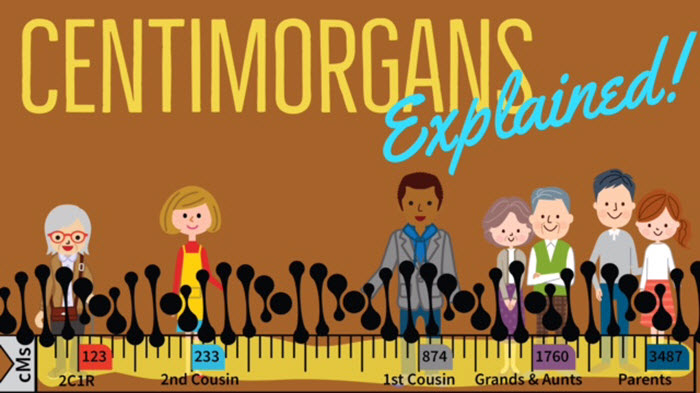
How DNA Tests Measure Genetic Relationships
 When we are looking at genetic relationships, there are also many ways we can measure them. But ultimately, we want the testing company to tell us how likely it is that a particular individual shares a single, recent common ancestor with us. One factor in this calculation is to take into account the total amount of DNA we share with that match.
When we are looking at genetic relationships, there are also many ways we can measure them. But ultimately, we want the testing company to tell us how likely it is that a particular individual shares a single, recent common ancestor with us. One factor in this calculation is to take into account the total amount of DNA we share with that match.
Currently, all the testing companies are reporting this sum in centimorgans (cMs). Every company reports to you the total number of shared cMs, as outlined below.
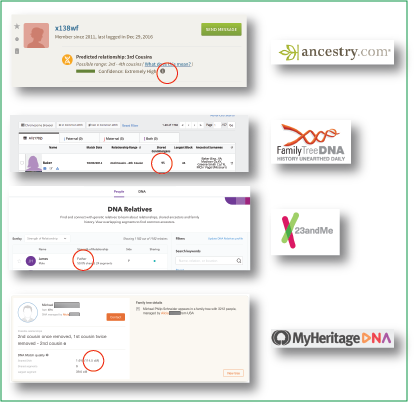 AncestryDNA: Click on the match to access the personal profile page for that match. In the second section, under Predicted Relationship, you will see the confidence level. To the right of the confidence level, you will see a grey circle with a little “i” in it. Clicking there will show you the total amount of shared cMs as well as how many pieces of DNA you share.
AncestryDNA: Click on the match to access the personal profile page for that match. In the second section, under Predicted Relationship, you will see the confidence level. To the right of the confidence level, you will see a grey circle with a little “i” in it. Clicking there will show you the total amount of shared cMs as well as how many pieces of DNA you share.- Family Tree DNA: On the main match page for your Family Finder results, you will see the total amount of shared cMs in the third column.
- 23andMe: You can see the percentage of shared DNA from the main DNA Relatives home page. To convert the percentage into centimorgans, just multiply your percentage by 68 (that will at least get you close). You can also see total shared cMs in the chromosome browser tool (go to Tools > DNA Relatives > DNA).
- MyHeritageDNA: The total amount of shared DNA is shown on the main match page under the title Match Quality. MyHeritage also has a new DNA Match Review page. Click here to read more about that.
Centimorgan: A Genetic “Crystal Ball”
 It is very tempting to think of a cM just like you would think of an inch or a centimeter, and for all practical purposes, that is okay. But it is actually much more complicated than that.
It is very tempting to think of a cM just like you would think of an inch or a centimeter, and for all practical purposes, that is okay. But it is actually much more complicated than that.
A cM is actually more like a crystal ball: it helps us predict how likely a piece of DNA looks exactly as it did a generation ago. This, in turn, helps us calculate how far back we should be looking for the common ancestor between two people.
But for our practical purposes, you can use the total amount of shared DNA, in combination with this chart compiled by Blaine Bettinger and the Shared cM Project, to better assess your genealogical relationship with your match based on your genetics.
To use the chart, take the total amount of shared DNA you have with a match, and look up that number in the chart to get an idea of what kind of genealogical relationship might best fit the genetics that you see. For example, if I share 69 cM with my match, we might be third cousins. But we might also be second cousins once or twice removed.
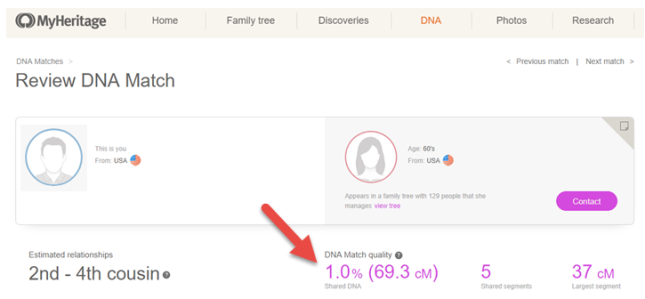
How do you figure out which one? Simply put: do genealogy research! It’s time to use traditional records and research skills to better understand the genetic clues in your family history mysteries.

My series of DNA quick reference guides can help you get the most out of your DNA tests for family history. I definitely recommend the value-priced bundle of all 10 guides. But I especially recommend the guides listed below if you’re to the point where you’re trying to understand what genetic relationships mean:
Thanks for sharing this post with someone who would enjoy reading it! You’re a gem!
Disclosure: This article contains affiliate links and Genealogy Gems will be compensated if you make a purchase after clicking on these links (at no additional cost to you). Thank you for supporting Genealogy Gems!

by Lisa Cooke | Aug 19, 2015
These Google keyword search tips can help you harness the incredible power of Google to search for your ancestors across trillions of webpages!
Do you use Google for genealogy? This free, powerful web browser will scan over 30 trillion webpages for information we request: our ancestors’ names, messages from those with common ancestors, or pictures and stories relating to our relatives’ lives.
However, it’s all too easy to run a Google search for an ancestor’s name–and then become discouraged when we see a quarter million search results. Especially if the first few results don’t seem relevant at all! We may give up, unaware that the gem we’re after is among our results, but much further down the list.
Certain Google keyword search tips and tricks can help you get exactly the types of search results you’re after. Once you learn Google search strategies for genealogy, you’ll find yourself using the same strategies to find other things online, from recipes to how-tos to old car manuals or anything else you need!
Here’s how to get started
1. Go to the Google home page and enter a few keywords relating to a piece of information you hope to find online. Say, an ancestor’s full name and hometown such as Andrew Larsen Scranton PA. Or a type of record you need and the location (probate records Lackawanna County PA). As you see from these examples, you don’t need commas in between your words or any other punctuation, at least to begin with. After entering a few keywords, hit Enter.
2. Look at your search results. The first few may be sponsored search results, or results that appear on websites that are paying for you to see them first. These results may or may not be what you’re looking for. Scan them, but keep looking!
3. Do you see too many search results? Too few? Not quite on target? Add or subtract keywords as needed, and search again. For example, if your search for probate records Lackawanna County PA just brings up current probate records, add the word genealogy. If Andrew Larsen Scranton PA doesn’t bring up any relevant results, try omitting his first name from the search. Then results for anyone with that surname will come up.
4. Still not quite right? It may be time to start adding little codes to tell Google exactly what you want.
5 Google Search Strategies That Get Better Results
Search operators are symbols and words that instruct Google on what to do with the keywords you provide in your search query. Get ready to talk Google’s language with these 5 strategies:
1. Quotation Marks (“ ”). One of the quickest ways to improve your search results is to use quotation marks. Using quotation marks around a phrase ensures that this exact phrase appears in each and every result. For example: “U.S. Federal Census” returns websites featuring that exact phrase, and no variation. “Jehu Burkhart” returns only webpages that include the exact name Jehu Burkhart somewhere on the page. Keep in mind though that if Jehu’s name appears as Burkhart, Jehu on a web page it will not appear in your results list.
2. OR. Use this to provide for more options in Google search results. For example, we can solve the last name first, first name last problem like this: “Jehu Burkhart” OR “Burkart, Jehu”. Not be sure whether Great Grandmother Smith is buried in Manhattan or Brooklyn? Search for cemeteries in either city: Cemeteries Manhattan OR Brooklyn.
3. Minus Sign (-). Let’s say that you are searching a Harold Carter from Springfield, Ohio and there happens to be a prominent man named Harold Carter from Springfield, Missouri who keeps popping up in your search results. Ask yourself: “what’s unique about this other person that I could eliminate from my Google search?” If the unwanted Mr. Carter was married to Mabel and owned a steel factory, you could try this approach:“Harold Carter” “Springfield” Missouri -Mabel -Steel. By using the minus sign operator you can sweep this Mr. Carter from Missouri out of the way and off your results page.
4. Numrange (00..18). The numrange command adds a range of numbers to your search parameters. To enter the command, type the beginning number, then two periods (no spaces), then the ending number. Use this feature to include the timeframe of your ancestor’s life in your online search. “Harold Carter” “Springfield” 1865..1934.

Google Search Example
5. Mix and Match. As you can already see in the above examples, it is perfectly acceptable to mix and match search operators. Here’s a search query that makes use of our first four strategies: “Harold Carter” OR “Carter Harold” “Springfield” Missouri -Mabel -Steel 1865..1934
Resources for Success
Use Google Search Operators to Define Old or Unfamiliar Words
Can Google Help Me Search Digitized Newspaper Pages?
Google for Genealogy: New Search Operators and More (podcast episode, available to Premium members)
The Genealogist’s Google Toolbox
The Genealogist’s Google Toolbox has become the “Google bible for genealogists.” Now in its second edition, the book was fully revised and updated in 2015. A lot has changed since the first edition was published in 2011, and it’s all documented step-by-step in this new edition.
This brand new edition includes:
- Google Search
- Google Alerts
- Gmail
- Google Books
- Google Translate
- YouTube
- Google Earth
- Brand new chapters on Google Scholar and Google Patents
 It’s Nice to Share. Do you have friends who would benefit from this article on using Google for genealogy and Google keyword search tips. Please share this article with them. You will find handy sharing buttons on this page, or just copy and paste the URL for this article into a Facebook post or email. Thanks!
It’s Nice to Share. Do you have friends who would benefit from this article on using Google for genealogy and Google keyword search tips. Please share this article with them. You will find handy sharing buttons on this page, or just copy and paste the URL for this article into a Facebook post or email. Thanks!
by Lisa Cooke | Nov 20, 2014 | 01 What's New, Ancestry, Brick Wall, DNA
“This is really the first time a DNA testing company has so fully integrated genetics and genealogy. We can now find cousins in the database who do not share our particular genetics, but who do share some of the genetics of our common ancestor. This is huge.” -Diane Southard, Your DNA Guide
I blogged a couple of weeks ago about some changes taking place over at AncestryDNA . You will recall that they are planning to slash your match list
. You will recall that they are planning to slash your match list 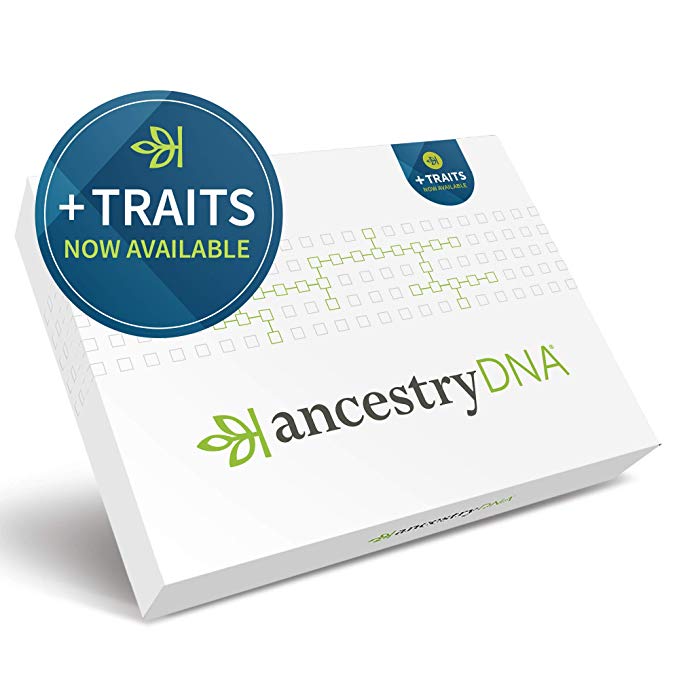 to allow only “invited guests” to your personal DNA party. (Read that post to be reminded why this is a good thing.)
to allow only “invited guests” to your personal DNA party. (Read that post to be reminded why this is a good thing.)
Ancestry has officially announced the launch of this feature update and reports that on average users will see an 80% reduction in the number of matches shown. I had a chance to look at the new site before it launched and one of my favorite features is the question mark that appears next to your match. Clicking on the question mark on your match page will bring up a menu of references to help you better understand the inner workings of matching at Ancestry, including those confidence levels that are a part of every relationship prediction. In this table below you can see that ancestry has tried to give you some fairly solid guidelines by which to assess the quality of your matches. You will want to focus on those matches with a confidence score of “High” or above to have the best chance of genealogical success. 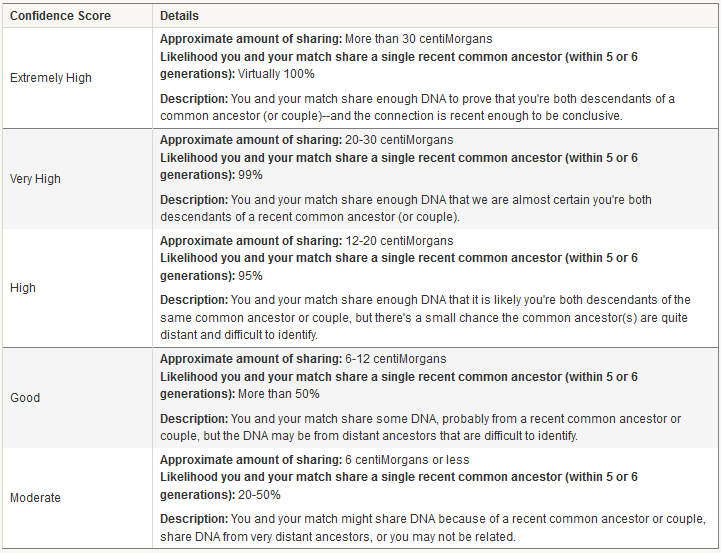 But an update to the matching feature is only the beginning of the new features at AncestryDNA
But an update to the matching feature is only the beginning of the new features at AncestryDNA . Today Ancestry announced “DNA Circles,” a tool that helps you identify others who share common ancestors with you. The new “DNA Circles” feature has the potential to impact the way you do genetic genealogy at Ancestry. Here’s why: Autosomal DNA (the kind that Ancestry is testing) has a spotty inheritance pattern. On average we only have half of the DNA of each of our parents, only 25% of our grandparents, only 12.5% of our great grandparents and so on. This means that AncestryDNA and its competitors (Family Tree DNA and 23andMe) are only able to genetically identify 50% of your genetic 4th cousins. This means that there could be 50% MORE people in these databases that you are actually related to, people that should have been invited to your DNA party, but didn’t have a ticket. Now with DNA Circles, there is a metaphorical “after-party.” After parties are “hosted” by one of your relatives. Ancestry searches your pedigree and that of your matches back 7 generations looking for suitable hosts. An ancestor qualifies as a host if they have two or more descendants who hold an invitation. At this after-party you can meet some of these long lost cousins that, while related to you, lost their ticket to your DNA party. After-party invitations are provided to those who meet three very important qualifications:
. Today Ancestry announced “DNA Circles,” a tool that helps you identify others who share common ancestors with you. The new “DNA Circles” feature has the potential to impact the way you do genetic genealogy at Ancestry. Here’s why: Autosomal DNA (the kind that Ancestry is testing) has a spotty inheritance pattern. On average we only have half of the DNA of each of our parents, only 25% of our grandparents, only 12.5% of our great grandparents and so on. This means that AncestryDNA and its competitors (Family Tree DNA and 23andMe) are only able to genetically identify 50% of your genetic 4th cousins. This means that there could be 50% MORE people in these databases that you are actually related to, people that should have been invited to your DNA party, but didn’t have a ticket. Now with DNA Circles, there is a metaphorical “after-party.” After parties are “hosted” by one of your relatives. Ancestry searches your pedigree and that of your matches back 7 generations looking for suitable hosts. An ancestor qualifies as a host if they have two or more descendants who hold an invitation. At this after-party you can meet some of these long lost cousins that, while related to you, lost their ticket to your DNA party. After-party invitations are provided to those who meet three very important qualifications:
- They have their DNA attached to their PUBLIC family tree.
- AND that PUBLIC family tree has the name of the hosting ancestor on it.
- AND this person shares DNA with at least one other person who also meets the above two criteria.
Here’s an example. Below is an image of the new AncestryDNA home page. You can see I am a part of two DNA Circles (some of you will be much more popular and invited to several after-parties. For me–just the two for now). Let’s take a closer look at my DNA Circle hosted by my paternal 5th great grandfather Minus Griggs (who knew the guy liked parties?!).  Clicking on the DNA circle brings up this page where there are three things I want to show you:
Clicking on the DNA circle brings up this page where there are three things I want to show you: 
- This is your relationship to the host.
- This is a list of the individuals who have passed the three criteria listed above and have been invited to this after-party.
- This is the innovative part. You see that the first two matches (after me–I am listed first) have only “Tree Match” in this column. This means that these two people, both descendants of our host, Minus Griggs, didn’t ever appear on my DNA match list. We do not share enough DNA to be considered genetic relatives. However, the third member of the circle has the “DNA Match” designation, meaning that this match DOES appear on my match page. In fact, this is my ONLY DNA match in the circle (there are three others not shown here). That means that this DNA circle has connected me to FIVE other cousins. All because I share DNA and genealogy with the third member of this circle, and he shares DNA and genealogy with everyone else.
I can click on each circle member to see exactly how Ancestry THINKS we are related. This is my first opportunity to DOUBLE CHECK this relationship that Ancestry has handed me, to be sure that both my match and I really did receive tickets to the same after party.
Here is what that page looks like for me and one of my matches.
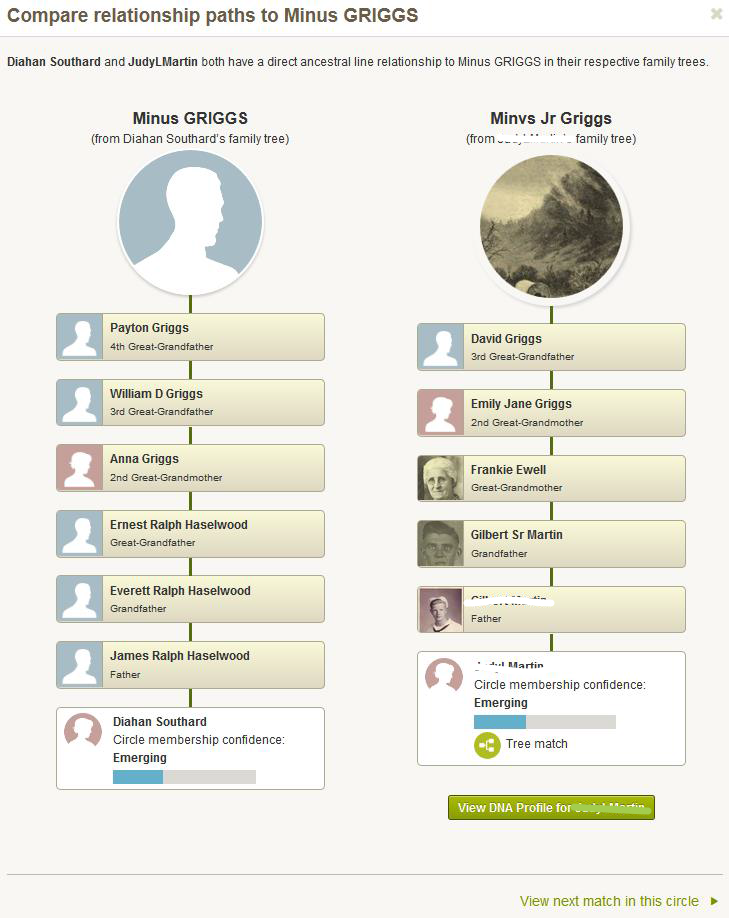 This is really the first time a DNA testing company has so fully integrated genetics and genealogy. We can now find cousins in the database who do not share our particular genetics, but who do share some of the genetics of our common ancestor. In my opinion, this is huge.
This is really the first time a DNA testing company has so fully integrated genetics and genealogy. We can now find cousins in the database who do not share our particular genetics, but who do share some of the genetics of our common ancestor. In my opinion, this is huge.
There is one catch, and it is going to be a big one for some of you. In order to see your DNA Circles, you have to be an Ancestry.com subscriber.
Even though I am excited about these changes, I can’t help but hope for just one step more. In order to identify these DNA Circles, Ancestry has identified pieces of DNA that can be fairly reliably assigned to a particular ancestor. There are likely others in the Ancestry database who have these pieces of DNA, we can call them partial tickets to the after-party, but who are lacking the second requirement: a pedigree documenting a relationship to that ancestor. I hope in the future the folks at Ancestry will honor those partial ticket holders, and allow them to the after-party, so we can sit around with our peanuts and pretzels and figure out how we are all related. Until then, I am going to enjoy the two after-parties hosted by my two generous ancestors.
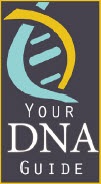 Ready to walk through the process of using DNA for your genealogy? Let me be your guide! Check out my quick
Ready to walk through the process of using DNA for your genealogy? Let me be your guide! Check out my quick  guides (left) Purchase each guide individually or pick up the bundle of all 4 for the best deal!
guides (left) Purchase each guide individually or pick up the bundle of all 4 for the best deal!
Visit my website to learn about expert consultations with me. You’ll get customized guidance on which tests to order and how to maximize your results for your genealogy research.
by Lisa Cooke | Aug 14, 2011 | 01 What's New, Inspiration
We all have cookbooks in our kitchen, many of which were handed down to us by our mothers and grandmothers. In addition to be overflowing with delectable recipes, they are often brimming with family history. Today I’d like to share with you a recipe mystery that followed me for years, and the bit of genealogical serendipity that solved it.

I once gave a presentation called Inspiring Ways to Capture the Interest of the Non-Genealogists in Your Family at a local genealogical society. (Genealogy Gems Premium Members can log in and watch this vide class as part of their membership here.)
In it, I gave an example of some items I had found on Ebay from my husband’s Larson family. If you listen to the Genealogy Gems Podcast then you have heard me mention the Larson family. They hailed from Winthrop Minnesota and owned a hardware store and lumber business there for many years.
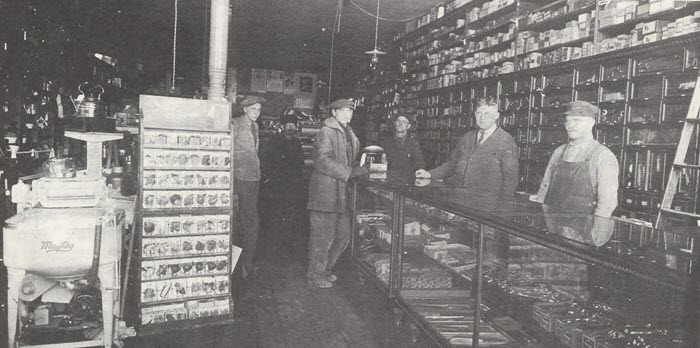
LJ Larson Hardware store
While I was taking questions toward the end of the presentation a woman in the front raised her hand. Her name was Harriet, and she said she was sure that she had a cookbook from Winthrop, Minnesota in her collection of books at home. She offered to send it to me and I gladly gave her my email address so we could connect.
Considering that Winthrop is such a small town, it make her statement surprising indeed! To provide perspective: Winthrop is about 1 square mile and the population hovers somewhere around 1300. So, I was surprised indeed to have someone in Pleasanton, California telling me that she had a cookbook that dated back to the early 20th century from this little town.
As promised, Harriett followed up with me by email. She asked for my address and told me that the book “looks a little worn but all of the pages are there. I hope it can be of some use to you. My sister taught either first grade or kindergarten there during World War 2 and that’s how it came in to her possession.”
The Cookbook Filled with Family History
Harriett was a woman of her word because about a week later the 340 Home Tested Recipes cookbook compiled by members of The Ladies Aid of the First Lutheran Church of Winthrop, Minnesota was in my mailbox.
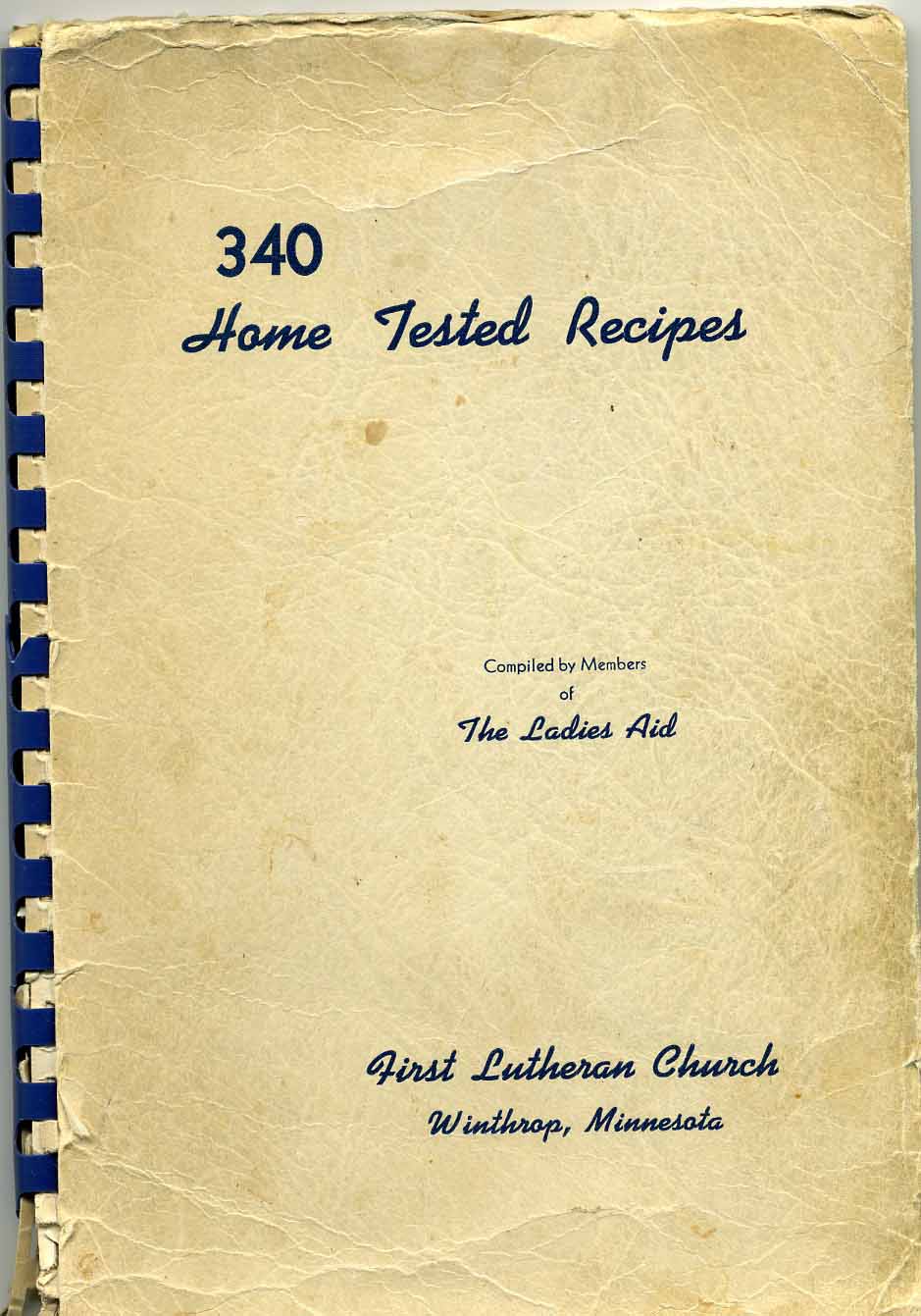
The Winthrop Cookbook
It continues to amaze and delight me how powerful just putting your family history “out there” is. By regularly mentioning real people and places in your own research, it so often leads to information and items that just seem to be waiting to be found. It’s what we call “genealogical serendipity” in genealogy circles.
But the genealogical serendipity didn’t end there. Not only did my husband’s ancestors contribute recipes to this little community cookbook, which of course I was thrilled to find – but there was a recipe in there that I had been in search of for over 25 years.
The Great Cookie Mystery
You see, when Bill and I got married, he shared his fond memories of a sour cream cookie his grandmother used to make. I’m an avid baker, so I checked with his mom to see if she had the recipe. Sadly, she didn’t.
Over the years I have tried to find a recipe for sour cream cookies in an attempt to recreate them. Every time I found one, I whipped up a batch. Bill would take a bite and shake his head saying they’ were good, but they weren’t like grandma’s cookies.

Bill enjoying baked treats with his Grandma Helen (Larson) Mansfield.
So as you can imagine, the first thing I looked for when I received this cookbook from the town where Bill’s grandma was born, was a recipe for sour cream cookies. There were many yummy-sounding treats to comb through like Pecan Sticks, Victoria Cookies, Father and Son Favorite Cookies, and Sorghum Cookies.
I got excited as I came across names I recognized from the family tree including Mrs. Sheldon S. Larson, the mother of a cousin we had the good fortune to finally meet two years ago when I presented a genealogy seminar in Minnesota at the Swedish Genealogical Society.
But the real thrill came when I made my way to page 42. There I found a recipe for Sour Cream Drop Cookies:

The infamous sour cream cookie recipe!
Surprisingly, the recipe wasn’t contributed by Bill’s grandma Helen (Larson) Mansfield or anyone named Larson. Instead it was submitted for inclusion in the cookbook by Mrs. Hulda Anderson. That fact didn’t deter me from trying it out. In a small town like Winthrop, recipes likely were regularly swapped and handed down through various families.
I immediately baked a batch and served them up to Bill. I’ll never forget his eyes as they lit up in excitement! He took a bite, and was ecstatic to once again be tasting Grandma’s sour cream cookies!
It may sound like a small victory in the scheme of thing, but for me it was a thrilling one, none the less!
I emailed Harriet and told her the good news and thanked her profusely.
I got a reply from her husband George. He wrote:
“I thought I would add a little amusement to the coincidence of the Sour Cream cookies. My father, George Anderson, Sr., was a salesman for American Steel and Wire, subsidiary of U. S. Steel, from the 1920s to the 1960s, traveling to every hardware store and lumber yard in southern Minnesota to sell fence, posts, nails etc. I don’t have any record of it, but I’m sure he would have called on your family’s hardware store in Winthrop. He knew all of his customers by first name, no doubt your in-laws included.”
Genealogy Serendipity never tasted so good!
A Genealogical Look at the Cookbook
I looked through the book carefully for a publishing date but none was to be found. However, there were several clues including the name of the church and the pastors name:
First Lutheran Church
Lambert Engwall, Pastor
To put these clues to use, I headed to Google and searched the name of the church, the location and the name of the pastor:
first lutheran church winthrop minnesota lambert engwall, pastor

Googling the church, location and pastor
The first result was just what I needed. The link to me to a Wikipedia page about the church:

The church in Wikipedia
It was a fairly comprehensive page, and I was specifically looking for a list of pastors who had served at the church. To save time, I used Control + F (PC) to trigger a find on page search bar. I searched for “pastor” and was immediately take much further down the page to exactly what I wanted to know.
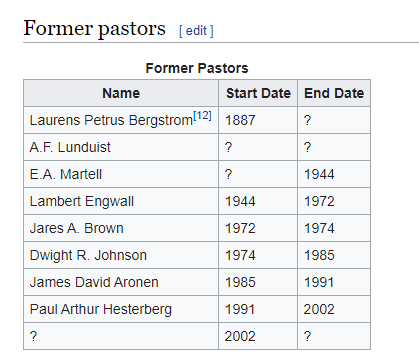
A helpful list of previous pastors
I quickly learned that Lambert Engwall served at this church in Winthrop, Minnesota from 1944 to 1972. Given that Harriett through it hailed from the World War II era when her sister lived there, and from the condition and style of the book, I feel confident it was published closer to 1944.
The next steps to learn more about the relationship between the Andersons and Larson include could include:
- Reviewing the 1940 census for Winthrop, Sibley County, Minnesota, and mapping their homes in Google Earth.
- conducting additional research into church and their available records include church meeting minutes.
- A comprehensive search of the Winthrop News newspaper, with a particular eye on the social pages.
Share Your Genealogical Serendipity and Cookbook Stories
Have you experienced glorious instances of genealogical serendipity in your own family history quest? Do you have a cookbook that has been handed down to you that you treasure? Please leave a comment below and share your story!
Resources





 When we are looking at genetic relationships, there are also many ways we can measure them. But ultimately, we want the testing company to tell us how likely it is that a particular individual shares a single, recent common ancestor with us. One factor in this calculation is to take into account the total amount of DNA we share with that match.
When we are looking at genetic relationships, there are also many ways we can measure them. But ultimately, we want the testing company to tell us how likely it is that a particular individual shares a single, recent common ancestor with us. One factor in this calculation is to take into account the total amount of DNA we share with that match. AncestryDNA
AncestryDNA It is very tempting to think of a cM just like you would think of an inch or a centimeter, and for all practical purposes, that is okay. But it is actually much more complicated than that.
It is very tempting to think of a cM just like you would think of an inch or a centimeter, and for all practical purposes, that is okay. But it is actually much more complicated than that.





 It’s Nice to Share. Do you have friends who would benefit from this article on using Google for genealogy and Google keyword search tips. Please share this article with them. You will find handy sharing buttons on this page, or just copy and paste the URL for this article into a Facebook post or email. Thanks!
It’s Nice to Share. Do you have friends who would benefit from this article on using Google for genealogy and Google keyword search tips. Please share this article with them. You will find handy sharing buttons on this page, or just copy and paste the URL for this article into a Facebook post or email. Thanks! to allow only “invited guests” to your personal DNA party. (
to allow only “invited guests” to your personal DNA party. (


 This is really the first time a DNA testing company has so fully integrated genetics and genealogy. We can now find cousins in the database who do not share our particular genetics, but who do share some of the genetics of our common ancestor. In my opinion, this is huge.
This is really the first time a DNA testing company has so fully integrated genetics and genealogy. We can now find cousins in the database who do not share our particular genetics, but who do share some of the genetics of our common ancestor. In my opinion, this is huge. 
 guides (left) Purchase each guide individually or pick up the
guides (left) Purchase each guide individually or pick up the 







